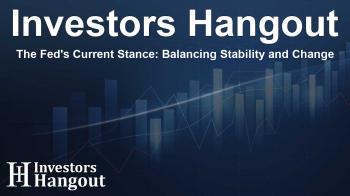The Fed's Current Stance: Balancing Stability and Change

The Fed's Recent Approach to Monetary Policy
The Federal Reserve's latest meeting was anticipated to be uneventful, and it delivered on that expectation by keeping the federal funds rate steady in a range of 4.25% to 4.50%. This stable approach reflects not only a commitment to current economic conditions but also a cautious outlook towards future adjustments.
Understanding the Fed's Patient Stance
Chair Powell emphasized that the Fed is "not in a hurry" to make any rate changes, which is a reasonable position given the prevailing economic indicators. The unemployment rate has shown little fluctuation, remaining at 4.1%. Additionally, real GDP growth has exceeded the Fed's long-term estimate, signifying strong economic performance.
Focus on Inflation
Despite the solid growth figures, inflation remains a concern. December's Core PCE inflation was reported at 2.8%, which, while a significant reduction from the highs seen in 2022, still strays from the Fed's 2% target. The Fed views its current interest rate as restrictive, suggesting that a prolonged period of stability might be necessary until inflation shows more consistent signs of declining towards the desired level.
Inflation Trends and Economic Outlook
While some quick improvements in inflation data are possible, the Fed's deliberate pace means that any decision to cut rates will hinge on several months of favorable reports. This cautious approach poses its own challenges, as lagging effects of monetary policy might mean that prolonged high rates could inadvertently stifle economic progress.
Balancing Economic Indicators and Independence
During the press conference, Powell made it clear that he would refrain from commenting on external political policies, especially those from the current administration. This highlights the Fed's prioritization of its independence in monetary decisions over engaging in political discourse.
Implications of Tariff Policies
The looming potential for tariffs on trade partners represents one of the many uncertainties affecting the economy. Even as the Fed maintains its focus on domestic monetary policy, external factors like tariffs could notably impact its decision-making, underlining the delicate balance the Fed must navigate.
Normalizing Economic Uncertainty
Powell attempted to contextualize economic uncertainty within traditional boundaries, contrasting it with the extraordinary unpredictability experienced during the pandemic and the financial crisis of 2008. He indicated that while current uncertainties are notable, they remain manageable when viewed against those historical backdrops.
Conclusion: A Cautious Yet Vigilant Fed
The Fed's decision to remain steady demonstrates a careful balancing act between fostering economic stability and preparing for potential shifts. Moving forward, it will be essential for the Fed to monitor economic developments closely while maintaining its commitment to data-driven decisions and the overarching goal of reaching its inflation targets.
Frequently Asked Questions
What does the Fed's current stance indicate about future rate changes?
The Fed's current stance suggests they are unlikely to alter rates soon unless there are significant changes in economic indicators, particularly inflation.
How does inflation impact the Fed's decision-making?
Inflation plays a crucial role in the Fed's policy decisions; high inflation may prompt the Fed to consider rate increases, while lower rates may lead to cuts.
Why is the Fed concerned about tariffs?
Tariffs could influence inflation and economic growth, which directly affects the Fed's monetary policy decisions and their overall economic outlook.
What are the risks of the Fed's slow approach?
A slow approach to rate adjustments risks unnecessary economic restrictions, like slowed growth or increased unemployment, before inflation reaches target levels.
How does current economic uncertainty compare to past events?
Current uncertainties are viewed as typical, especially when compared to the unprecedented volatility of the pandemic and the financial crisis of 2008.
About The Author
Contact Dominic Sanders privately here. Or send an email with ATTN: Dominic Sanders as the subject to contact@investorshangout.com.
About Investors Hangout
Investors Hangout is a leading online stock forum for financial discussion and learning, offering a wide range of free tools and resources. It draws in traders of all levels, who exchange market knowledge, investigate trading tactics, and keep an eye on industry developments in real time. Featuring financial articles, stock message boards, quotes, charts, company profiles, and live news updates. Through cooperative learning and a wealth of informational resources, it helps users from novices creating their first portfolios to experts honing their techniques. Join Investors Hangout today: https://investorshangout.com/
The content of this article is based on factual, publicly available information and does not represent legal, financial, or investment advice. Investors Hangout does not offer financial advice, and the author is not a licensed financial advisor. Consult a qualified advisor before making any financial or investment decisions based on this article. This article should not be considered advice to purchase, sell, or hold any securities or other investments. If any of the material provided here is inaccurate, please contact us for corrections.

